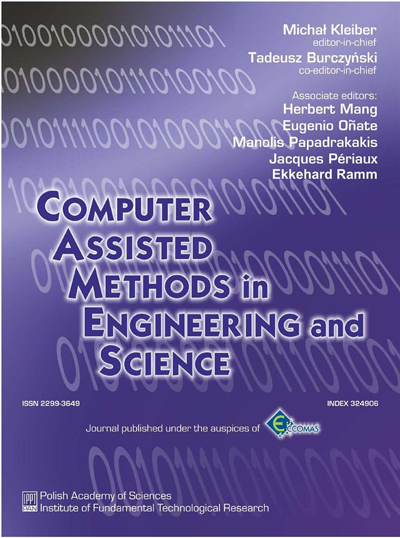Understanding Bézier Extraction, Bézier Elements, and Hermite Elements in NURBS-Based Isogeometric Analysis
Abstract
This paper discusses the current need for Bézier extraction in isogeometric analysis (IGA), and proposes a straightforward procedure to improve the accuracy of the numerical solution without increasing the number of B-spline elements. It shows that after knot insertion, where the shape and parameterization of the domain are preserved, the number of degrees of freedom (DOFs) leading to enhanced numerical accuracy of the numerical solution increases as well. Of particular interest is the fact that the control points implicitly introduced during Bézier extraction in IGA can be explicitly used to form Bézier elements with C0-continuity in several ways. Similarly, for any inner knot multiplicity less than the polynomial degree p, accuracy increases while maintaining the same number of B-spline elements. In conclusion, the set of the extracted Bézier or Hermite elements eventually leads to superior accuracy and performance compared to Cp−1-continuity. Nevertheless, if we consider a certain fixed number of DOFs for all three competing models (for p = 3), results show that the C2-continuous model is the most accurate, while the C1-continuous model (Hermite extraction) is more accurate than the C0-continuous model (Bézier extraction). The study includes six static and eigenvalue potential problems with known closed-form exact solution.
Keywords
Bézier extraction, isogeometric analysis, NURBS and finite elements and Helmholtz equation, error estimator,References
1. O.C. Zienkiewicz, The Finite Element Method, 3rd ed., McGraw-Hill, London, 1977.2. K.J. Bathe, Finite Element Procedures, Prentice-Hall, New Jersey, 1996.
3. C.G. Provatidis, Precursors of Isogeometric Analysis: Finite Elements, Boundary Elements and Collocation Methods, Springer, Cham, 2019, https://doi.org/10.1007/978-3-030-03889-2.
4. C. De Boor, The Method of Projections as Applied to the Numerical Solutions of Two Point Boundary Value Problems using Cubic Splines, Ph.D. thesis, University of Michigan, 1966.
5. M.G. Cox, The numerical evaluation of B-splines, International Journal of Mathematics and its Applications, 10(2): 134–149, 1972, https://doi.org/10.1093/imamat/10.2.134.
6. C. De Boor, On calculating with B-splines, Journal of Approximation Theory, 6(1): 50–62, 1972, https://doi.org/10.1016/0021-9045(72)90080-9.
7. K. Böhmer, Spline-Funktionen. Theorie und Anwendungen [in German], Teubner Verlag, Stuttgart, 1974.
8. K. Höllig, Finite Element Methods with B-splines, SIAM, Philadelphia, 2003.
9. J. Kong, Y.K. Cheung, Application of the spline finite strip to the analysis of shear-deformable plates, Computers & Structures, 46(6): 985–988, 1993, https://doi.org/10.1016/0045-7949(93)90083-P.
10. A.Y.T. Leung, F.T.K. Au, Spline finite elements for beam and plate, Computers & Structures, 31(5): 717–729, 1990, https://doi.org/10.1016/0045-7949(90)90100-G.
11. I.J. Schoenberg, Contributions to the problem of approximation of equidistant data by analytic functions. Part A. On the problem of smoothing or graduation. A first class of analytic approximation formulae, Quarterly of Applied Mathematics, 4(1): 45–99, 1946.
12. H.B. Curry, I.J. Schoenberg, On Polya frequency functions IV: The fundamental spline functions and their limits, Journal d’Analyse Mathématique, 17(1): 71–107, 1966, https://doi.org/10.1007/BF02788653.
13. L. Piegl, W. Tiller, The NURBS Book, 2nd ed., Springer, Berlin, 1997.
14. C. De Boor, A Practical Guide to Splines. Revised Edition, Springer, New York, 2001.
15. C. Provatidis, A. Kanarachos, Performance of a macro-FEM approach using global interpolation (Coons’) functions in axisymmetric potential problems, Computers & Structures, 79(19): 1769–1779, 2001, https://doi.org/10.1016/S0045-7949(01)00101-8.
16. J.A. Cottrell, T.J.R. Hughes, Y. Bazilevs, Isogeometric Analysis: Towards Integration of CAD and FEA, Wiley, Chichester, 2009.
17. T.J.R. Hughes, J.A. Cottrell, Y. Bazilevs, Isogeometric analysis: CAD, finite elements, NURBS, exact geometry and mesh refinement, Computer Methods in Applied Mechanics and Engineering, 194(39–41): 4135–4195, 2005, https://doi.org/10.1016/j.cma.2004.10.008.
18. T.J.R. Hughes, A. Reali, G. Sangalli, Efficient quadrature for NURBS-based isogeometric analysis, Computer Methods in Applied Mechanics and Engineering, 199(5–8): 301–313, 2010, https://doi.org/10.1016/j.cma.2008.12.004.
19. F. Auricchio, F. Calabr`o, T.J.R. Hughes, A. Reali, G. Sangalli, A simple algorithm for obtaining nearly optimal quadrature rules for NURBS-based isogeometric analysis, Computer Methods in Applied Mechanics and Engineering, 249–252: 15–27, 2012, https://doi.org/10.1016/j.cma.2012.04.014.
20. D. Schillinger, S.J. Hossain, T.J.R. Hughes, Reduced Bézier element quadrature rules for quadratic and cubic splines in isogeometric analysis, Computer Methods in Applied Mechanics and Engineering, 277: 1–45, 2014, https://doi.org/10.1016/j.cma.2014.04.008.
21. M.A. Scott, M.J. Borden, C.V. Verhoosel, T.W. Sederberg, Isogeometric finite element data structures based on Bézier extraction of T-splines, International Journal for Numerical Methods in Engineering, 88(2): 126–156, 2011, https://doi.org/10.1002/nme.3167.
22. A.V. Vuong, Ch. Heinrich, B. Simeon, ISOGAT: A 2D tutorial MATLAB code for isogeometric analysis, Computer Aided Geometric Design, 27(8): 644–655, 2010, https://doi.org/10.1016/j.cagd.2010.06.006.
23. C. De Falco, A. Reali, R. Vázquez, GeoPDEs: A research tool for isogeometric analysis of PDEs, Advances in Engineering Software, 42(12): 1020–1034, 2011, https://doi.org/10.1016/j.advengsoft.2011.06.010.
24. V.P. Nguyen, C. Anitescu, S.P.A. Bordas, T. Rabczuk, Isogeometric analysis: An overview and computer implementation aspects, Mathematics and Computers in Simulation, 117: 89–116, 2015, https://doi.org/10.1016/j.matcom.2015.05.008.
25. M.J. Borden, M.A. Scott, J.A. Evans, T.J.R. Hughes, Isogeometric finite element data structures based on Bézier extraction of NURBS, International Journal for Numerical Methods in Engineering, 87(1–5): 15–47, 2011, https://doi.org/10.1002/nme.2968.
26. G.F. Carey, J.T. Oden, Finite Elements: A Second Course, Vol. 2., Prentice-Hall, Englewood Cliffs, NJ, 1983.
27. C. Provatidis, I. Dimitriou, Automatic handling of C0-G0 continuous rational Bézier elements produced from T-splines through Bézier extraction, Mathematics, 13(3): 377, 2025, https://doi.org/10.3390/math13030377.

This work is licensed under a Creative Commons Attribution 4.0 International License.




